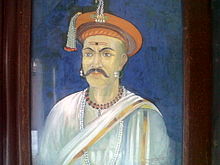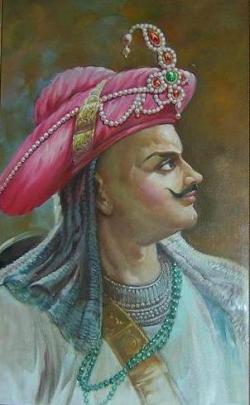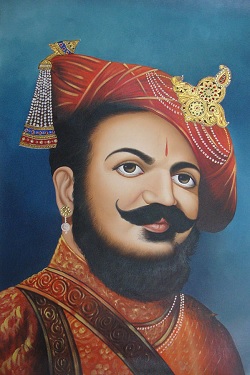Shahu, son of Shambhuji who was imprisoned by Aurangzeb in 1689, was released by Prince Azam Shah in 1707, with the purpose of dividing the Marathas. Shahu claimed to be the King of the Marathas. Tara Bai, widow of Raja Ram, opposed him as regent of his son Shivaji II and claimed that his son was the rightful claimant to the throne of the Marathas. Shahu, finally succeeded in the contest against her and became the Chhatrapati of the Marathas. Shahu was neither a capable administrator nor a good commander but he had the capacity to choose capable subordinates and command their loyalty. His Peshwas were chosen by him and his first three Peshwas achieved all that which he himself could not achieve. The Marathas reached the zenith of their power during the rule of Shahu and the credit of it goes entirely to his Peshwas. All the three Peshwas of Shahu – Balaji Vishwanath, Baji Rao and Balaji Baji Rao – were competent. They made the Marathas the strongest power in India and themselves the most powerful persons among the Marathas so much so that after the death of Shahu the Peshwas eclipsed the Chhatrapati and assumed all powers of the state to themselves.
Factors that led to the rise of the Peshwas
Several factors led to the rise of the Peshwas. While Chhatrapati Shahu was an ease-loving person, Tari Bai was selfish and narrow-minded. None of them was able to provide peace and security to Maharashtra. The Asht-Pradhan, created by Shivaji too had become ineffective in administration. In these circumstances, the Maratha nobles were contending among themselves for power. The Peshwas of Shahu, found solutions to these problems by their capabilities. They rose to be good diplomats and commanders. They provided the Marathas an ideal – ideal of extending their power and influence towards the North. They rose above all other Maratha chiefs by sheer merit and they also led them to become the foremost power in India.
Peshwa Balaji Vishwanath
The first Peshwa of Shahu was Balaji Vishwanath (1713-20 A.D.). He was the Sar Subahdar of Poona and Daulatabad when Shahu entered Maharashtra after his release from imprisonment of the Mughals.

He sided with Shahu and also brought Dhanaji Jadav, the commander-in-chief of Tara Bai, to the rise of Shahu which helped him in capturing the throne of Maharashtra. Vishwanath further helped Shahu in consolidating his power in Maharashtra. Vishwanath was not a good commander and his attempt to improve the finances of the state also failed. But he was an astute diplomat. He convinced most of the Maratha chiefs of the necessity of accepting Shahu as the Chhatrapati of the Marathas and, thus, brought them under his banner. The one creditable achievement of Vishwanath was signing of a treaty between Shahu and the Mughals in 1719. Sayyad Hussain Ali desired to befriend the Marathas with a view to dethroning the Mughal emperor Farrukhsiyar and, therefore, approached Shahu for this purpose. Vishwanath advised Shahu to accept the offer and a treaty was signed between Shahu, on the one hand, and the Mughal emperor on the other. By this treaty, the Marathas received the right of collecting Chauth and Sardeshmukhi from the six subas of the Deccan. In return, the Marathas went to Delhi with Sayyad Hussain Ali and helped Sayyad brothers in deposing emperor Farrukhsiyar from the throne. The right of collecting Chauth and Sardeshmukhi from the six provinces of the Deccan provided the Marathas the opportunity to extend their power in the Deccan while their visit to Delhi made them clear the weakness of the Mughal empire which aroused their ambition to penetrate in the North. Thus, this treaty helped in the rise of the Marathas afterwards.
Peshwa Baji Rao
Vishwanath died in 1720 and Shahu chose his twenty year old-son Baji Rao as his Peshwa. Vishwanath had only consolidated power of Shahu in Maharashtra and prepared the background for the expainsion of the Maratha power. Baji Rao, within twenty years, made the Marathas the strongest power in India. He proved himself an ambitious person and a successful commander. He achieved what Marathas even did not dream of at that time. In fact, he was primarily responsible for the rise of the Maratha power in India and therefore, has been ranked among the great Peshwas.

However, initially, Baji Rao had to face many difficulties. He had to face both internal and external enemies. He had several rivals at the court of Chhatrapati Shahu. Senapati Trimbak Rao was jelous of him. He opposed and conspired against Baji Rao from the very beginning. He refused to share the jagir of Gujarat and Malwa with the Peshwa. However, Baji Rao finally defeated him and killed him at the battle of Dabhai in April 1731. Baji Rao faced opposition of Pratinidhi Sripat Rao on matters of state-policy. While Sripat Rao desired that the Marathas should concentrate their energy in the Deccan, Baji Rao pleaded that the Marathas should extent their power in North. Baji Rao had realized the weakness of the Mughal empire and attempted to draw maximum advantages out of it.
He said “Let us strike at the trunk of the withering tree, the branches will fall themselves.” Sripat Rao could be convinced of the righteousness of the policy of Baji Rao only after his repeated success against the Nizam of Hyderabad. The Marathas then started raiding northern India and succeeded in capturing the provinces of Gujarat, Malwa and parts of Doab and Bundelkhand. Thus, Baji Rao extended the Maratha empire in northern India and the territories of the Maratha kingdom became most extensive in India.
In Deccan, Baji Rao was stoutly opposed by Nizam-ul-mulk Asaf Jah, the founder ruler of the state of Hyderabad. The Nizam was an astute diplomat and the most experienced military commander among the Mughals. He carved out an independent kingdom for himself in the Deccan. The Marathas alone were capable of challenging him and were the greatest impediments in his ambition and attempt of strengthening and extending the power and territories of his sate. He understood that Baji Rao was his sole opponent among the Marathas. There he always opposed him and encouraged all his enemies. However, Baji Rao repeatedly outmanoeuvred him, defeated him twice and forced him to sign the treaties of Mungi-Shegaon and Durai Sarai in 1728 and 1738 respectively. It was a remarkable success of Baji Rao. Shambhuji II of Kolhapur was a cousin of Chhatrapati Shahu. He opposed Shahu and claimed Chauth and Sardeshmukhi from the six provinces of the Deccan for himself. He was, however, defeated and forced to accept Shahu as his overlord by the treaty of Varna in 1731. Baji Rao also strengthened the hold of the Marathas over Konkan, while the Sidis of Janjira accepted peace with the Marathas. The Angrias, another naval power in the Konkan coast accepted the services of Shahu. Thus, Baji Rao succeeded everywhere. His success was primarly due to the power of the sword. He died of illness in 1740. But prior to it, he had made the Marathas the foremost power in India.
Peshwa Balaji Baji Rao
After the death of Peshwa Baji Rao, Shahu appointed his son Balaji as his Peshwa while he was only eighteen years of age. Balaji Baji Rao pursued the policy of extending the territory and sphere of influence of the Marathas like his father. Balaji himself was no military commander but the Marathas, who had already penetrated in northern India, went on increasing their power and by 1752 claimed Chauth and Sardeshmukhi practically from all over India. They interfered in the politics of Delhi and practically from all over India. They interfered in the politics of Delhi and virtually made the Mughal emperor dependent on themselves. Thus, the Maratha power reached its zenith when Balaji was the Peshwa of Shahu.

However, the Marathas received a serious setback to their power during this period. The interference of the Marathas in the politics of Delhi brought them in conflict with Ahmad Shah Abdali which, finally, resulted in the third battle of Panipat in January 1761. The Marathas were severely defeated in the battle. It checked their power and ambition. It permitted other native as well as foreign powers to consolidate their strength. Balaji died in 1761. His son, Peshwa Madhav Rao I, of course, consolidated the Maratha power again but the Marathas never regained the status which they enjoyed till 1761.
Conclusion
Therefore, we can say that the first three Peshwas of Shahu made the Marathas the most formidable power in India. The Marathas enjoyed that power and prestige in India which they did not enjoy prior to them or after them.
Points to Remember
- The failure of Shahu, Tara Bai and the Asht Pradhan in providing peace to Maharashtra and checking ambitious of Maratha chiefs provided opportunity to the Peshwas to rise above all of them. They also provided them the ideal of extending Maratha influence towards the North.
- Balaji Vishwanath, the first Peshwa of Chhatrapati Shahu, helped him in getting the throne of the Marathas by bringing Dhanaji Jadav, the commander-in-chief of Tara Bai, to his side.
- Vishwanath also helped Shahu in consolidating his power in Maharashtra by bringing most of the Maratha chiefs under his suzerainty.
- However, the best success of the diplomacy of Vishwanath was the treaty between Shahu and the Mughal emperor in 1719.
- The Marathas went to Delhi and Sayyad Hussain Ali when the weakness of the Mughals became clear to them and that encouraged them to penetrate in the North.
- Besides, by this treaty, the Marathas got the right of collecting Chauth and Sardeshmukhi from the six provinces of the Deccan which gave them the opportunity of extending their power in the Deccan.
- The second Peshawa, Baji Rao, was a great military commander. He made the Marathas the greatest power in India.
- Baji Rao succeeded, both, against his internal and external enemies.
- He killed Senapati Trimbak Rao, who was jealous of him, at the battle of Dabhai in 1731.
- He convinced Pratinidhi Sripat Rao of his policy of extending the Maratha power in the North by his military success, particularly against the Nizam of Hyderabad.
- The Marathas succeeded in capturing the provinces of Gujarat, Malwa and parts of Doab and Bundelkhand.
- Baji Rao forced Nizam-ul-mulk Asaf Jah of Hyderabad to sign the treaties of Mungi-Shegaon and Durai Sarai in 1728 and 1738 respectively.
- A cousin of Shahu, Shambhuji II of Kolhapur who opposed his claim over Chauth and Sardeshmukhi from the six provinces of the Deccan was forced to accept his suzerainty of the treaty of Varna in 1731.
- Baji Rao strengthened the hold of the Marathas over Konkan; the Sidis of Janjira accepted peace with the Marathas; and the Angrias accepted the services of Shahu.
- Maratha power reached itz zenith under the leadership of the third Peshwa, Balaji Baji Rao.
- The Marthas claimed Chauth and Sardeshmukhi from all over India by 1752 under the command of Balaji.
- Balaji interfered in the politics of Delhi and virutually made the Mughal emperor dependent on the Marathas.
- However, the Marthas received a serious setback to their power when Balaji was the Peshwa. The Marathas were badly defeated by Ahmad Shah Abdali in the third battle of Panipat in 1761.
Mains Question
Trace the rise of the Maratha power under the first three Peshwas.
Source used : NCERT, Tamil Nadu Board, IGNOU Modern History, NIOS textbooks.
Access this page to read all notes of >> Modern Indian History